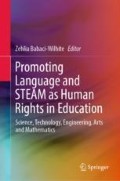Abstract
In this chapter I go beyond the concept of STEM, to present in contemporary educational proposals for the entire world. The first strategies of the human species to deal with are natural facts and phenomena; these are generally embraced by concept of Technology. Early humans generated ad-hoc solutions to satisfy their needs for survival. From shelter to nourishment, these solutions were essential in the evolution of the species. The emotional evolution of the species led to generating ad-hoc solutions to satisfy their desire which transcend needs. Next, probably the turning point in the evolution of the species was to recognize that how to face an ad-hoc situation might be used in other similar situations. This means, recognizing that the “hows” constitute methods. This step leads to ask why and in which circumstances methods work. This is the quintessence of Science. Understanding how and why, humans venture into the new, imagining new representations of the real, thus creating Arts, and innovating with the introduction of new material constructs, thus creating Engineering. But Science required new intellectual instruments to understand the “hows” and “whys”. These intellectual instruments gave rise origin to Mathematics. Thus, the evolution of material and intellectual instruments developed by the human species is the evolution of Technology, Science, Arts, Engineering and Mathematics. Even ignoring historical precedence, a central topic in Education is Science, Technology, Arts, Engineering and Mathematics or STEAM. STEAM is a response to natural and social environment and, together with mythology, the support of culture. I use a metaphor. STEAM was decisive for the emergence of the Industrial Era. Thus the metaphorical figure of the STEAM as the fuel that moves mankind to the future.
Access this chapter
Tax calculation will be finalised at checkout
Purchases are for personal use only
Notes
- 1.
This approach is adopted, with respect to blood and HIV, in the Project REPO history. Circulation, Art Journal, vol. 59, nº4, 2000, pp. 38–53.
- 2.
To access information and publications on Ethnomathematics visit http://isgem.rpi.edu the site of the ISGEm: International Study Group on Ethnomathematics.
References
Casacuberta, C., & Castellet, M. (Eds.). (1992). Mathematical research today and tomorrow, viewpoints of seven field medalists (p. 88). Berlin: Springer.
D’Ambrosio, U. (1992). Ethnomathematics: A research program on the history and pedagogy of mathematics with pedagogical implications. Notices of the American Mathematical Society, December 1992 (vol. 39, n°10, pp. 1183–1185).
D’Ambrosio, U., et al. (1992). Final report on Science, mathematics, engineering, and technology education for the 21st century. Summer Symposium on Educating for Citizenship in the 21st Century, National Science Foundation, Directorate for Education and Human Resources, Division of Research, Evaluation and Dissemination, Washington DC, 1993 [ED 373 993SE 054 763; NSF -94 -67].
Edwin A. Abbott (1984). Flatland. A romance of many dimensions (orig.edn.1884), reprinted with an Introduction by A. K. Dewdney, New American Library Inc., New York.
Flaubert, G. (1993). Bouvard et Pecuchet with the dictionary of received ideas. London: Penguin Books, 1987. This was the motivating caption of my paper on “Mathematics and literature”. In A. White (Ed.), Humanistic mathematics (pp. 35–47). Washington: The Mathematical Association of America.
Gopnik, A. (2009). The philosophical baby: What children’s minds tell us about truth, love, and the meaning of life. New York: Farrar, Straus and Giroux.
Klaus G. Witz (2007). Spiritual aspirations connected with mathematics: The experience of American University students. Lewiston NY: The Edwin Mellen Press.
Steen, L. A. (2001). Mathematics and democracy: The case for quantitative literacy (p. 1). Princeton, NJ: National Council on Education and the Disciplines.
Stubhaug, A. (2000). The Mathematician Sophus Lie (p. 143), New York: Springer.
van Oort, R. (1995, December). The anthropology of speech-act literary criticism: A review article. Anthropoetics I, no. 2, p. 8.
Author information
Authors and Affiliations
Corresponding author
Editor information
Editors and Affiliations
Rights and permissions
Copyright information
© 2019 Springer Nature Singapore Pte Ltd.
About this chapter
Cite this chapter
D’Ambrosio, U. (2019). Humanity Moving Since Pre-historic Times to the Future with Creative STEAM. In: Babaci-Wilhite, Z. (eds) Promoting Language and STEAM as Human Rights in Education. Springer, Singapore. https://doi.org/10.1007/978-981-13-2880-0_11
Download citation
DOI: https://doi.org/10.1007/978-981-13-2880-0_11
Published:
Publisher Name: Springer, Singapore
Print ISBN: 978-981-13-2879-4
Online ISBN: 978-981-13-2880-0
eBook Packages: EducationEducation (R0)

